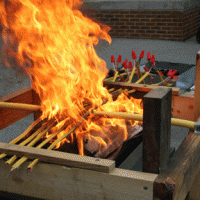One area that we have found particularly interesting are fires involving Corrugated Stainless Steel Tubing (CSST). CSST is a material used to plumb fuel gas inside structures. It is used as an alternative to traditional black steel pipe or copper tubing. The stainless steel tube of CSST, in certain circumstances, will perforate when subjected to electrical arcing, including that due to local lightning strikes. The escaping fuel gas from these perforations has obvious implications as to causing fires.
Any fires that potentially involve CSST should be carefully examined by investigators familiar with CSST and its installation requirements. Installation requirements are given in the specific manufacturer’s installation instructions and in NFPA 54, National Fuel Gas Code and in the International Fuel Gas Code. Interestingly, these installation requirements have undergone considerable changes in the last few years.
CSST fire investigations may lead to litigation over alleged defects in the CSST product and its installation. In some cases, it is alleged that holes found in CSST post fire investigations were actually caused by contact between CSST and energized electrical conductors under exposure from the fire. In this scenario, the holes could be considered “victim” holes and not causative in starting the fire. We were involved in a litigated CSST loss in which that assertion was made by an expert for the CSST manufacturer. We felt that the expert’s experimental work supporting his assertion was less than robust, therefore we decided that some alternative experimental work was in order to help determine if some CSST failures could be explained by this fire “victim” scenario.
The testing that we conducted, subjected energized non-metallic (NM) cable, in close contact with grounded CSST, to fire conditions. Multiple tests were run until either the overcurrent protection device (circuit breaker) opened or a hole was arced in the CSST, or both. These tests placed the CSST and NM cables in various arrangements, consistent with those that might occur in actual construction.

Figure 2: One of twelve tests where a junction of LP gas charged CSST and 5 sections of energized NM cable were subjected to fire conditions.
The testing indicated that it is possible to create arced holes in CSST by exposure to energized conductors in fire conditions. Of the 60 strands of NM cable that we exposed to fire conditions, 19 of those conductors arced to, and created holes in, the CSST. The testing also examined the morphology of the holes and conductors including SEM/EDS analysis. Observations of the stability of flames burning at the resulting gas jets were also made. These observations maybe helpful in determining the cause of holes found in CSST on fire scenes.
The experimentation work we performed was used as the basis of a technical paper: Analysis of the Potential for Perforation of Corrugated Stainless Steel Tube (CSST) by Energized Branch Circuits in Fire Conditions. This paper was peer reviewed and accepted for presentation at the 2014 International Symposium on Fire Investigation Science & Technology.
Founded in 1997, The Warren Group, forensic engineers and consultants provides technical investigations and analysis of personal injury and property claims as well as expert testimony for insurance adjusters and attorneys. Extremely well versed in the disciplines of mechanical, electrical, chemical, structural, accident reconstruction and fire and explosion investigation, our engineers and consultants are known for delivering the truth — origin, cause, responsibility and cost of an event or claim — with unmistakable clarity.




